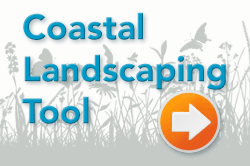About this Website
In order to capture the benefits of coastal riparian corridors, lessen the impacts from storm events while still allowing for view sheds and water access, we offer the following website as a resource for those living on or near the waters and tributaries of Long Island Sound. Instead of having lawn and turfgrass exclusively between the home and water, we suggest plantings that can withstand this harsh environment and show how plantings can be placed to still provide view sheds and water access, while incorporating the ecological benefits of riparian plantings.
"How To" Fact Sheets
This site includes a series of fact sheets describing
- functions and values of coastal riparian corridors
- how to prepare an area for planting
- how to plant.
Fact sheets as pdf
Plant Lists
We provide a listing of native plants and indicate their ability to withstand salt spray and inundation. We have developed a list of plants native to Connecticut and New York that grow well in the coastal areas of Long Island Sound. This is not an exhaustive list of plants, but rather is focused on native plants that are likely to be available at nurseries in this area.
Additionally, we provide a series of landscaping diagrams to get you started including both plan views and cross sections.
The plant table contains some of the plants that can live in riparian areas within the coastal reaches of Long Island Sound. It is safe to say that the list is not inclusive of all the plants that might be successfully used in a Connecticut or New York coastal riparian area. In compiling this list, care was taken to be sure to only list plants where there was consensus among sources as to the suitability for coastal planting. Whenever possible, use native plants as the first choice for planting riparian areas.
Additional Information
Step 1 - Locate Your Zone (pertaining to salt tolerance)
The Coastal Landscaping Tool is available to help you determine which landscaping option is right for you. Select how much salt spray you experience, if you have a sea wall or not, and the average slope of your property. Most of the plants listed in Step 2 have at least some tolerance to salt spray, but some are more tolerant than others. Some plants may also have tolerance to saline soils.
Answer the three questions below and then click the Submit button to see a conceptual cross section of your type of property, and recommendations on what Zone plants to use.

Does your property experience:
Does your property have:
The slope of your property is:
Step 2 - Select Plants
Proper plant selection is always important for all landscaping activities, but it is especially critical for coastal riparian plantings. Plants grown in close proximity to Long Island Sound will have to contend with direct exposure to the Sound. This means they will have to tolerate at least some of the following conditions: high wind; salt spray; direct sun exposure; infertile sandy soils; droughty soils; potential saltwater overwash; saline soils, poorly-drained soils. Since these conditions are generally difficult for most plants to tolerate, the list of suitable plants for coastal riparian plantings is somewhat limited.
View Plant List for Zone 1
Plants are those that are the toughest and exhibit the most salt tolerance. They generally can tolerate direct salt spray and possibly saltwater overwash. Low-lying areas, dunes and the areas immediately adjacent to Long Island Soundshould only be planted with species receiving a zone 1 rating.
View Plant List for Zone 2
Plants would be those used behind Zone 1 plants. They can tolerate moderate levels of salt spray without significant permanent damage. Generally zone 2 plants should receive some protection from direct, heavy salt spray either from other more tolerant plants, structures or distance from the water.
View Plant List for Zone 3
Plants are those with the least salt tolerance. The can be used behind Zone 2 plants and in areas that provide substantial protection from the direct impacts of salt spray and wind.




